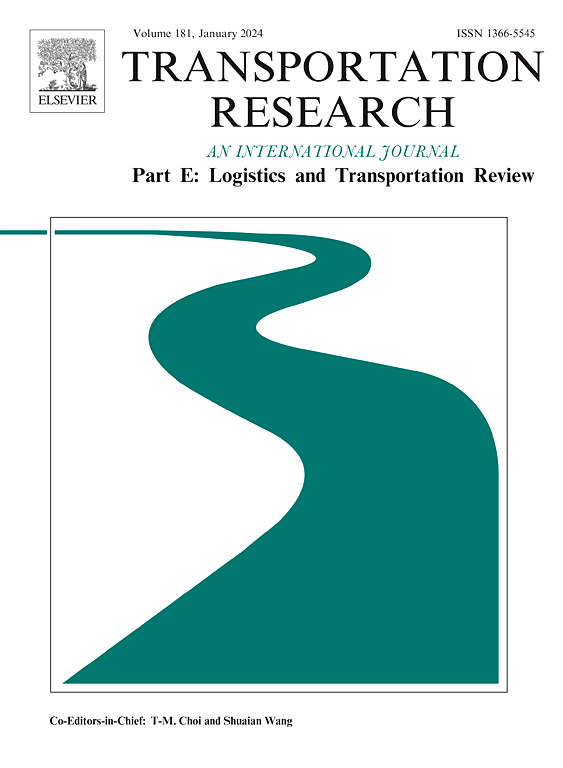多式联运系统中共享自动驾驶车辆混合所有权的车队规模和定价
IF 8.3
1区 工程技术
Q1 ECONOMICS
Transportation Research Part E-Logistics and Transportation Review
Pub Date : 2024-11-21
DOI:10.1016/j.tre.2024.103871
引用次数: 0
摘要
当全自动驾驶汽车即将私有化时,共享私人拥有的自动驾驶汽车(SPAVs)有望成为现有汽车共享和按需移动服务的主要替代品。在这种模式下,私人自动驾驶汽车的所有者将决定是否/何时/何地/多长时间共享他们的私人自动驾驶汽车,这将形成一个动态的私人自动驾驶汽车车队。为了提高这种交通系统的效率,可能还需要一定数量的共享商业自主车辆(SBAV)。本研究提出了一种考虑到共享自动驾驶汽车(SAVs)混合所有权的双层编程模型。上层优化 SBAV 的车队规模和 SAV 的租赁价格,涉及内生的 SPAV 车队;下层涉及 SAV 的自我定位策略,并关注旅行者的日常活动-旅行调度行为。针对双层次模型开发了一种涉及供需双方迭代调整的记忆算法。数值示例的结果表明,运营商提供的 SBAV 与 SPAV 相辅相成,共同满足移动需求,从而提高系统性能,而 PAV 的所有者则调整共享行为和日常日程安排,以减少活动-旅行的不便利性。本文章由计算机程序翻译,如有差异,请以英文原文为准。
Fleet sizing and pricing for hybrid ownership of shared autonomous vehicles in a multimodal transportation system
Shared privately-owned autonomous vehicles (SPAVs) are expected to be a primary alternative to existing car-sharing and on-demand mobility services when fully automated vehicles are soon to be privatized. In this paradigm, PAV owners make decisions on whether/when/where/for how long to share their PAVs, which would make a dynamic fleet of SPAVs. To improve the effectiveness of such a mobility system, a certain fleet of shared business-owned autonomous vehicles (SBAVs) may also be required. This study proposes a bi-level programming model considering the hybrid ownership of shared autonomous vehicles (SAVs). The upper level optimizes the fleet size of SBAVs and rental price of SAVs involving an endogenous fleet of SPAVs, and the lower level involves an SAV self-relocation strategy and attends to travelers’ daily activity-travel scheduling behaviors. A memetic algorithm involving iterative adjustments of the supply and demand sides is developed for the bi-level model. Results from numerical examples indicate that SBAVs provided by the operator complement SPAVs to serve the mobility demand to improve system performance, while PAVs owners adapt sharing behaviors and daily schedules to reduce activity-travel disutilities.
求助全文
通过发布文献求助,成功后即可免费获取论文全文。
去求助
来源期刊
CiteScore
16.20
自引率
16.00%
发文量
285
审稿时长
62 days
期刊介绍:
Transportation Research Part E: Logistics and Transportation Review is a reputable journal that publishes high-quality articles covering a wide range of topics in the field of logistics and transportation research. The journal welcomes submissions on various subjects, including transport economics, transport infrastructure and investment appraisal, evaluation of public policies related to transportation, empirical and analytical studies of logistics management practices and performance, logistics and operations models, and logistics and supply chain management.
Part E aims to provide informative and well-researched articles that contribute to the understanding and advancement of the field. The content of the journal is complementary to other prestigious journals in transportation research, such as Transportation Research Part A: Policy and Practice, Part B: Methodological, Part C: Emerging Technologies, Part D: Transport and Environment, and Part F: Traffic Psychology and Behaviour. Together, these journals form a comprehensive and cohesive reference for current research in transportation science.

 求助内容:
求助内容: 应助结果提醒方式:
应助结果提醒方式:


